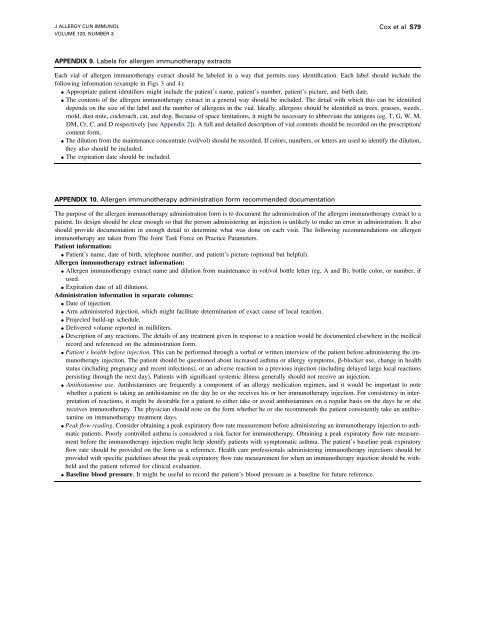Immunotherapy Safety for the Primary Care ... - U.S. Coast Guard
Immunotherapy Safety for the Primary Care ... - U.S. Coast Guard
Immunotherapy Safety for the Primary Care ... - U.S. Coast Guard
You also want an ePaper? Increase the reach of your titles
YUMPU automatically turns print PDFs into web optimized ePapers that Google loves.
J ALLERGY CLIN IMMUNOL<br />
VOLUME 120, NUMBER 3<br />
Cox et al S79<br />
APPENDIX 9. Labels <strong>for</strong> allergen immuno<strong>the</strong>rapy extracts<br />
Each vial of allergen immuno<strong>the</strong>rapy extract should be labeled in a way that permits easy identification. Each label should include <strong>the</strong><br />
following in<strong>for</strong>mation (example in Figs 3 and 4):<br />
d Appropriate patient identifiers might include <strong>the</strong> patient’s name, patient’s number, patient’s picture, and birth date.<br />
d The contents of <strong>the</strong> allergen immuno<strong>the</strong>rapy extract in a general way should be included. The detail with which this can be identified<br />
depends on <strong>the</strong> size of <strong>the</strong> label and <strong>the</strong> number of allergens in <strong>the</strong> vial. Ideally, allergens should be identified as trees, grasses, weeds,<br />
mold, dust mite, cockroach, cat, and dog. Because of space limitations, it might be necessary to abbreviate <strong>the</strong> antigens (eg, T, G, W, M,<br />
DM, Cr, C, and D respectively [see Appendix 2]). A full and detailed description of vial contents should be recorded on <strong>the</strong> prescription/<br />
content <strong>for</strong>m.<br />
d The dilution from <strong>the</strong> maintenance concentrate (vol/vol) should be recorded. If colors, numbers, or letters are used to identify <strong>the</strong> dilution,<br />
<strong>the</strong>y also should be included.<br />
d The expiration date should be included.<br />
APPENDIX 10. Allergen immuno<strong>the</strong>rapy administration <strong>for</strong>m recommended documentation<br />
The purpose of <strong>the</strong> allergen immuno<strong>the</strong>rapy administration <strong>for</strong>m is to document <strong>the</strong> administration of <strong>the</strong> allergen immuno<strong>the</strong>rapy extract to a<br />
patient. Its design should be clear enough so that <strong>the</strong> person administering an injection is unlikely to make an error in administration. It also<br />
should provide documentation in enough detail to determine what was done on each visit. The following recommendations on allergen<br />
immuno<strong>the</strong>rapy are taken from The Joint Task Force on Practice Parameters.<br />
Patient in<strong>for</strong>mation:<br />
d Patient’s name, date of birth, telephone number, and patient’s picture (optional but helpful).<br />
Allergen immuno<strong>the</strong>rapy extract in<strong>for</strong>mation:<br />
d Allergen immuno<strong>the</strong>rapy extract name and dilution from maintenance in vol/vol bottle letter (eg, A and B), bottle color, or number, if<br />
used.<br />
d Expiration date of all dilutions.<br />
Administration in<strong>for</strong>mation in separate columns:<br />
d Date of injection.<br />
d Arm administered injection, which might facilitate determination of exact cause of local reaction.<br />
d Projected build-up schedule.<br />
d Delivered volume reported in milliliters.<br />
d Description of any reactions. The details of any treatment given in response to a reaction would be documented elsewhere in <strong>the</strong> medical<br />
record and referenced on <strong>the</strong> administration <strong>for</strong>m.<br />
d Patient’s health be<strong>for</strong>e injection. This can be per<strong>for</strong>med through a verbal or written interview of <strong>the</strong> patient be<strong>for</strong>e administering <strong>the</strong> immuno<strong>the</strong>rapy<br />
injection. The patient should be questioned about increased asthma or allergy symptoms, b-blocker use, change in health<br />
status (including pregnancy and recent infections), or an adverse reaction to a previous injection (including delayed large local reactions<br />
persisting through <strong>the</strong> next day). Patients with significant systemic illness generally should not receive an injection.<br />
d Antihistamine use. Antihistamines are frequently a component of an allergy medication regimen, and it would be important to note<br />
whe<strong>the</strong>r a patient is taking an antihistamine on <strong>the</strong> day he or she receives his or her immuno<strong>the</strong>rapy injection. For consistency in interpretation<br />
of reactions, it might be desirable <strong>for</strong> a patient to ei<strong>the</strong>r take or avoid antihistamines on a regular basis on <strong>the</strong> days he or she<br />
receives immuno<strong>the</strong>rapy. The physician should note on <strong>the</strong> <strong>for</strong>m whe<strong>the</strong>r he or she recommends <strong>the</strong> patient consistently take an antihistamine<br />
on immuno<strong>the</strong>rapy treatment days.<br />
d Peak flow reading. Consider obtaining a peak expiratory flow rate measurement be<strong>for</strong>e administering an immuno<strong>the</strong>rapy injection to asthmatic<br />
patients. Poorly controlled asthma is considered a risk factor <strong>for</strong> immuno<strong>the</strong>rapy. Obtaining a peak expiratory flow rate measurement<br />
be<strong>for</strong>e <strong>the</strong> immuno<strong>the</strong>rapy injection might help identify patients with symptomatic asthma. The patient’s baseline peak expiratory<br />
flow rate should be provided on <strong>the</strong> <strong>for</strong>m as a reference. Health care professionals administering immuno<strong>the</strong>rapy injections should be<br />
provided with specific guidelines about <strong>the</strong> peak expiratory flow rate measurement <strong>for</strong> when an immuno<strong>the</strong>rapy injection should be withheld<br />
and <strong>the</strong> patient referred <strong>for</strong> clinical evaluation.<br />
d Baseline blood pressure. It might be useful to record <strong>the</strong> patient’s blood pressure as a baseline <strong>for</strong> future reference.
















